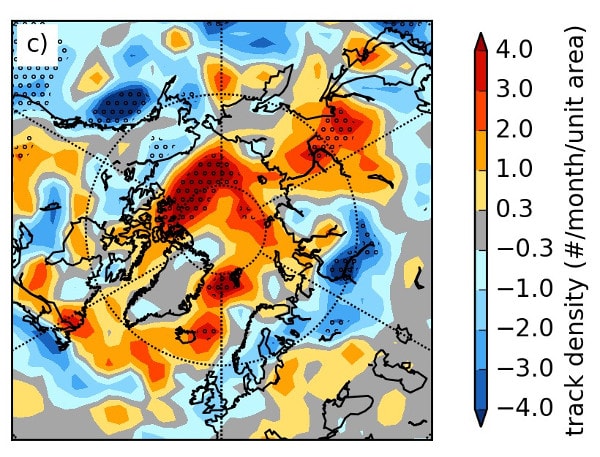In a paper now published in Geophysical Research Letters, British climate scientists Jonny Day and Kevin Hodges find that Arctic warming will increase both the number and intensity of storms in Arctic summer.

The dramatic reduction in Arctic summer sea ice has led to an increase in human activity and hence exposure to extreme events in the Arctic. Unlike the mid-latitude storm tracks, which are most active in winter, the Arctic storm track is most active in summer, exactly during the time when Arctic shipping and tourism are on the rise, leading to the obvious question of how climate change will affect the storms themselves. Unfortunately, climate models perform poorly in representing even the basic features, such as the summer maximum in Arctic cyclone frequency. As a result, climate model projections for how Arctic cyclones will change in the future cannot be considered reliable.
In a recent paper published in Geophysical Research Letters, APPLICATE scientist Jonny Day from the European Centre for Mid-Range Weather Forecasts (ECMWF) and Kevin Hodges from the University of Reading develop an analogue approach to assess the impact of Arctic warming on Arctic storms, using the ECMWF reanalysis, ERA-Interim, which performs well in the Arctic. Reanalyses use a combination of computer model simulations and observations to produce a gridded data set constrained by historical observations.
Because near-surface air temperatures over the Arctic Ocean and Arctic land areas are heating up at different rates, with the land heating up about twice as fast as the ocean, the authors hypothesize that the increase in coastal temperature gradients will make the Arctic a much more favorable place for future cyclone development. Day and Hodges compare cyclone statistics for years with high temperature contrast between land and at sea against years with low contrast, as an analogue for the effects of climate change. Based on this method, they argue that storms over the Arctic Ocean are likely to become more frequent and more dynamically intense as the Arctic warms, increasing the risk to shipping and other human activities.
{nomultithumb}
Day, J. J. & Hodges, K. I. (2018). Growing land‐sea temperature contrast and the intensification of Arctic cyclones. Geophysical Research Letters, 45. https://doi.org/10.1029/2018GL077587


